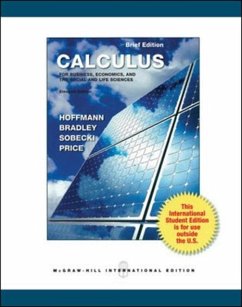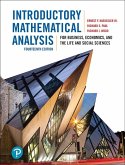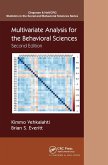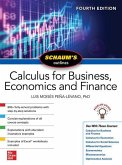Laurence Hoffmann, Gerald Bradley, David Sobecki
Calculus for Business, Economics, and the Social and Life Sciences, Brief Version (Int'l Ed)
Laurence Hoffmann, Gerald Bradley, David Sobecki
Calculus for Business, Economics, and the Social and Life Sciences, Brief Version (Int'l Ed)
- Broschiertes Buch
- Merkliste
- Auf die Merkliste
- Bewerten Bewerten
- Teilen
- Produkt teilen
- Produkterinnerung
- Produkterinnerung
Provides a sound, intuitive understanding of the basic concepts students need as they pursue careers in business, economics, and the life and social sciences. In this book, the author applies real-world orientation to concepts, problem-solving approach, straight forward and concise writing style, and comprehensive exercise sets.
Andere Kunden interessierten sich auch für
![Introductory Mathematical Analysis for Business, Economics, and the Life and Social Sciences, Global Edition Introductory Mathematical Analysis for Business, Economics, and the Life and Social Sciences, Global Edition]() Ernest HaeusslerIntroductory Mathematical Analysis for Business, Economics, and the Life and Social Sciences, Global Edition115,99 €
Ernest HaeusslerIntroductory Mathematical Analysis for Business, Economics, and the Life and Social Sciences, Global Edition115,99 €![Introductory Mathematical Analysis for Business, Economics, and the Life and Social Sciences Introductory Mathematical Analysis for Business, Economics, and the Life and Social Sciences]() Ernest HaeusslerIntroductory Mathematical Analysis for Business, Economics, and the Life and Social Sciences91,99 €
Ernest HaeusslerIntroductory Mathematical Analysis for Business, Economics, and the Life and Social Sciences91,99 €![Practice of Statistics in the Life Sciences, Digital Update (International Edition) Practice of Statistics in the Life Sciences, Digital Update (International Edition)]() Brigitte BaldiPractice of Statistics in the Life Sciences, Digital Update (International Edition)71,99 €
Brigitte BaldiPractice of Statistics in the Life Sciences, Digital Update (International Edition)71,99 €![Mathematical Methods in the Physical Sciences, Solutions Manual Mathematical Methods in the Physical Sciences, Solutions Manual]() Mary L. Boas (DePaul University)Mathematical Methods in the Physical Sciences, Solutions Manual73,99 €
Mary L. Boas (DePaul University)Mathematical Methods in the Physical Sciences, Solutions Manual73,99 €![How to Talk to Anybody - Learn The Secrets To Small Talk, Business, Management, Sales & Social Skills & How to Make Real Friends (Communication Skills) How to Talk to Anybody - Learn The Secrets To Small Talk, Business, Management, Sales & Social Skills & How to Make Real Friends (Communication Skills)]() Derek BorthwickHow to Talk to Anybody - Learn The Secrets To Small Talk, Business, Management, Sales & Social Skills & How to Make Real Friends (Communication Skills)22,99 €
Derek BorthwickHow to Talk to Anybody - Learn The Secrets To Small Talk, Business, Management, Sales & Social Skills & How to Make Real Friends (Communication Skills)22,99 €![Multivariate Analysis for the Behavioral Sciences, Second Edition Multivariate Analysis for the Behavioral Sciences, Second Edition]() Kimmo VehkalahtiMultivariate Analysis for the Behavioral Sciences, Second Edition53,99 €
Kimmo VehkalahtiMultivariate Analysis for the Behavioral Sciences, Second Edition53,99 €![Schaum's Outline of Calculus for Business, Economics and Finance, Fourth Edition Schaum's Outline of Calculus for Business, Economics and Finance, Fourth Edition]() Luis Moises Pena-LevanoSchaum's Outline of Calculus for Business, Economics and Finance, Fourth Edition27,99 €
Luis Moises Pena-LevanoSchaum's Outline of Calculus for Business, Economics and Finance, Fourth Edition27,99 €-
-
-
Provides a sound, intuitive understanding of the basic concepts students need as they pursue careers in business, economics, and the life and social sciences. In this book, the author applies real-world orientation to concepts, problem-solving approach, straight forward and concise writing style, and comprehensive exercise sets.
Produktdetails
- Produktdetails
- Verlag: McGraw-Hill Education - Europe
- 11 ed
- Seitenzahl: 800
- Erscheinungstermin: 16. Dezember 2012
- Englisch
- Abmessung: 254mm x 202mm x 25mm
- Gewicht: 1762g
- ISBN-13: 9780071310710
- ISBN-10: 0071310711
- Artikelnr.: 42379607
- Herstellerkennzeichnung
- Libri GmbH
- Europaallee 1
- 36244 Bad Hersfeld
- gpsr@libri.de
- Verlag: McGraw-Hill Education - Europe
- 11 ed
- Seitenzahl: 800
- Erscheinungstermin: 16. Dezember 2012
- Englisch
- Abmessung: 254mm x 202mm x 25mm
- Gewicht: 1762g
- ISBN-13: 9780071310710
- ISBN-10: 0071310711
- Artikelnr.: 42379607
- Herstellerkennzeichnung
- Libri GmbH
- Europaallee 1
- 36244 Bad Hersfeld
- gpsr@libri.de
Laurence D. Hoffmann November 2011 I consider myself to be a writer and expositor as well as a mathematician, and these traits led to the original version of this text published in 1975. Before assuming my current position as a Senior Investment Management Consultant with Morgan Stanley Smith Barney, I was a tenured professor of mathematics at Claremont McKenna College, where, on three occasions, I was honored to be the recipient of the Huntoon Award for Excellence in Teaching, a "best-teacher" award determined by a vote of the students. In addition to my current profession and my ongoing involvement with this text, I serve on the Strategic Planning committee of the Claremont Community foundation and on the Investment Committee of the Rancho Santa Ana Botanic Gardens in Claremont. My wife, Janice, and I love to travel, enjoy music and the arts, have two grown sons, three grandchildren and two Maltese dogs. I am an avid (but average) tennis player, am addicted to the Sunday Puzzle on NPR, and have been trying for several years to become fluent in Italian. Long ago, I received by BA in mathematics from Brown University and my Ph.D. in mathematics from the University of Wisconsin.
Chapter 1: Functions, Graphs, and Limits
1.1Functions
1.2The Graph of a Function
1.3Lines and Linear Functions
1.4Functional Models
1.5Limits
1.6One-Sided Limits and Continuity
Chapter 2: Differentiation: Basic Concepts
2.1The Derivative
2.2Techniques of Differentiation
2.3Product and Quotient Rules; Higher-Order Derivatives
2.4The Chain Rule
2.5Marginal Analysis and Approximations Using Increments
2.6Implicit Differentiation and Related Rates
Chapter 3: Additional Applications of the Derivative
3.1 Increasing and Decreasing Functions; Relative Extrema
3.2 Concavity and Points of Inflection
3.3 Curve Sketching
3.4 Optimization; Elasticity of Demand
3.5 Additional Applied Optimization
Chapter 4: Exponential and Logarithmic Functions
4.1 Exponential Functions; Continuous Compounding
4.2 Logarithmic Functions
4.3 Differentiation of Exponential and Logarithmic Functions
4.4 Additional Applications; Exponential Models
Chapter 5: Integration
5.1 Indefinite Integration and Differential Equations
5.2 Integration by Substitution
5.3 The Definite Integral and the Fundamental Theorem of Calculus
5.4 Applying Definite Integration: Distribution of Wealth and Average Value
5.5 Additional Applications to Business and Economics
5.6 Additional Applications to the Life and Social Sciences
Chapter 6: Additional Topics in Integration
6.1 Integration by Parts; Integral Tables
6.2 Numerical Integration
6.3 Improper Integrals
6.4 Introduction to Continuous Probability
Chapter 7: Calculus of Several Variables
7.1 Functions of Several Variables
7.2 Partial Derivatives
7.3 Optimizing Functions of Two Variables
7.4 The Method of Least-Squares
7.5 Constrained Optimization: The Method of Lagrange Multipliers
7.6 Double Integrals
Appendix A: Algebra Review
A.1 A Brief Review of Algebra
A.2 Factoring Polynomials and Solving Systems of Equations
A.3 Evaluating Limits with L'Hopital's Rule
A.4 The Summation Notation
1.1Functions
1.2The Graph of a Function
1.3Lines and Linear Functions
1.4Functional Models
1.5Limits
1.6One-Sided Limits and Continuity
Chapter 2: Differentiation: Basic Concepts
2.1The Derivative
2.2Techniques of Differentiation
2.3Product and Quotient Rules; Higher-Order Derivatives
2.4The Chain Rule
2.5Marginal Analysis and Approximations Using Increments
2.6Implicit Differentiation and Related Rates
Chapter 3: Additional Applications of the Derivative
3.1 Increasing and Decreasing Functions; Relative Extrema
3.2 Concavity and Points of Inflection
3.3 Curve Sketching
3.4 Optimization; Elasticity of Demand
3.5 Additional Applied Optimization
Chapter 4: Exponential and Logarithmic Functions
4.1 Exponential Functions; Continuous Compounding
4.2 Logarithmic Functions
4.3 Differentiation of Exponential and Logarithmic Functions
4.4 Additional Applications; Exponential Models
Chapter 5: Integration
5.1 Indefinite Integration and Differential Equations
5.2 Integration by Substitution
5.3 The Definite Integral and the Fundamental Theorem of Calculus
5.4 Applying Definite Integration: Distribution of Wealth and Average Value
5.5 Additional Applications to Business and Economics
5.6 Additional Applications to the Life and Social Sciences
Chapter 6: Additional Topics in Integration
6.1 Integration by Parts; Integral Tables
6.2 Numerical Integration
6.3 Improper Integrals
6.4 Introduction to Continuous Probability
Chapter 7: Calculus of Several Variables
7.1 Functions of Several Variables
7.2 Partial Derivatives
7.3 Optimizing Functions of Two Variables
7.4 The Method of Least-Squares
7.5 Constrained Optimization: The Method of Lagrange Multipliers
7.6 Double Integrals
Appendix A: Algebra Review
A.1 A Brief Review of Algebra
A.2 Factoring Polynomials and Solving Systems of Equations
A.3 Evaluating Limits with L'Hopital's Rule
A.4 The Summation Notation
Chapter 1: Functions, Graphs, and Limits
1.1Functions
1.2The Graph of a Function
1.3Lines and Linear Functions
1.4Functional Models
1.5Limits
1.6One-Sided Limits and Continuity
Chapter 2: Differentiation: Basic Concepts
2.1The Derivative
2.2Techniques of Differentiation
2.3Product and Quotient Rules; Higher-Order Derivatives
2.4The Chain Rule
2.5Marginal Analysis and Approximations Using Increments
2.6Implicit Differentiation and Related Rates
Chapter 3: Additional Applications of the Derivative
3.1 Increasing and Decreasing Functions; Relative Extrema
3.2 Concavity and Points of Inflection
3.3 Curve Sketching
3.4 Optimization; Elasticity of Demand
3.5 Additional Applied Optimization
Chapter 4: Exponential and Logarithmic Functions
4.1 Exponential Functions; Continuous Compounding
4.2 Logarithmic Functions
4.3 Differentiation of Exponential and Logarithmic Functions
4.4 Additional Applications; Exponential Models
Chapter 5: Integration
5.1 Indefinite Integration and Differential Equations
5.2 Integration by Substitution
5.3 The Definite Integral and the Fundamental Theorem of Calculus
5.4 Applying Definite Integration: Distribution of Wealth and Average Value
5.5 Additional Applications to Business and Economics
5.6 Additional Applications to the Life and Social Sciences
Chapter 6: Additional Topics in Integration
6.1 Integration by Parts; Integral Tables
6.2 Numerical Integration
6.3 Improper Integrals
6.4 Introduction to Continuous Probability
Chapter 7: Calculus of Several Variables
7.1 Functions of Several Variables
7.2 Partial Derivatives
7.3 Optimizing Functions of Two Variables
7.4 The Method of Least-Squares
7.5 Constrained Optimization: The Method of Lagrange Multipliers
7.6 Double Integrals
Appendix A: Algebra Review
A.1 A Brief Review of Algebra
A.2 Factoring Polynomials and Solving Systems of Equations
A.3 Evaluating Limits with L'Hopital's Rule
A.4 The Summation Notation
1.1Functions
1.2The Graph of a Function
1.3Lines and Linear Functions
1.4Functional Models
1.5Limits
1.6One-Sided Limits and Continuity
Chapter 2: Differentiation: Basic Concepts
2.1The Derivative
2.2Techniques of Differentiation
2.3Product and Quotient Rules; Higher-Order Derivatives
2.4The Chain Rule
2.5Marginal Analysis and Approximations Using Increments
2.6Implicit Differentiation and Related Rates
Chapter 3: Additional Applications of the Derivative
3.1 Increasing and Decreasing Functions; Relative Extrema
3.2 Concavity and Points of Inflection
3.3 Curve Sketching
3.4 Optimization; Elasticity of Demand
3.5 Additional Applied Optimization
Chapter 4: Exponential and Logarithmic Functions
4.1 Exponential Functions; Continuous Compounding
4.2 Logarithmic Functions
4.3 Differentiation of Exponential and Logarithmic Functions
4.4 Additional Applications; Exponential Models
Chapter 5: Integration
5.1 Indefinite Integration and Differential Equations
5.2 Integration by Substitution
5.3 The Definite Integral and the Fundamental Theorem of Calculus
5.4 Applying Definite Integration: Distribution of Wealth and Average Value
5.5 Additional Applications to Business and Economics
5.6 Additional Applications to the Life and Social Sciences
Chapter 6: Additional Topics in Integration
6.1 Integration by Parts; Integral Tables
6.2 Numerical Integration
6.3 Improper Integrals
6.4 Introduction to Continuous Probability
Chapter 7: Calculus of Several Variables
7.1 Functions of Several Variables
7.2 Partial Derivatives
7.3 Optimizing Functions of Two Variables
7.4 The Method of Least-Squares
7.5 Constrained Optimization: The Method of Lagrange Multipliers
7.6 Double Integrals
Appendix A: Algebra Review
A.1 A Brief Review of Algebra
A.2 Factoring Polynomials and Solving Systems of Equations
A.3 Evaluating Limits with L'Hopital's Rule
A.4 The Summation Notation








